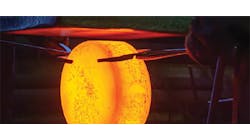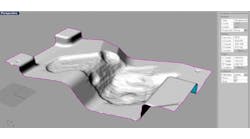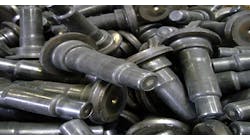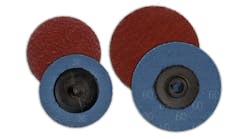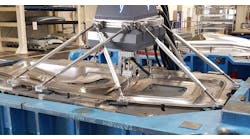A: The sketches you sent indicate that the flash developed in the blocker dies is significantly thicker than the flash in the finisher. As a general rule that is not all that bad, but when this occurs between impressions, the trapped flash metal has to have some place to go and, unless there is a gutter groove in the finisher die, this metal tends to flow through the adjacent forging causing a flow-thru defect. This probably what is causing the trim tears at that location. I would suggest designing the flash thickness in the blocker to be thinner between impressions than in the finisher, especially if there is insufficient room for a gutter between the finisher impressions.
Concerning the lower frequency of trim cracks being observed during cold trimming, I am not sure that they were not there but simply smeared over. To check this out, I would suggest cutting a cross-section through the suspect regions to determine the depths of the flow-through defects. I am sure you would not like to have product failures due to such defects.
Flow-through defects are more often observed when forging structural rib-web parts having surrounding ribs where the metal tends to flow out beneath the ribs unless the preforms and blockers are properly designed to encourage vertical flow. This usually means forging with surrounding flash that is thinner for the blocker impressions than for the finish impressions but with a much larger radius at the flash land. Also, the webs are often forged slightly thinner in the centers than the finishers or at least no thicker to avoid this problem. To be sure that the metal is encouraged to climb into the upper dies, the finish die has a sharper radius at the parting line and essentially “digs into” the blocker flash, thereby choking the metal from rapid escape and preventing flow-thru defects.For more than 40 years H. James Henning held key technical positions in the forging industry, including as director of technology for the Forging Industry Association, and as president of Henning Education Services, a Columbus, OH, firm specializing in customized education and training in forging technologies.
Guidelines and recommendations offered in this column are based on information believed to be reliable and are supplied in good faith but without guarantee. Operational conditions that exist in individual plants and facilities vary widely. Users of this information should adapt it, and always exercise independent discretion in establishing plant or facility operating practice.
